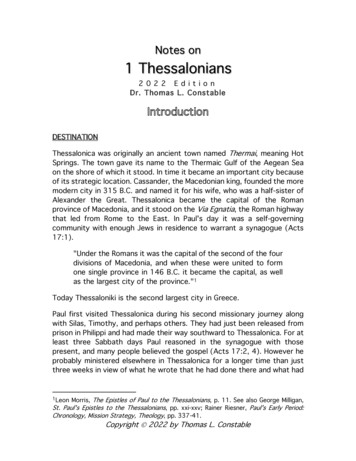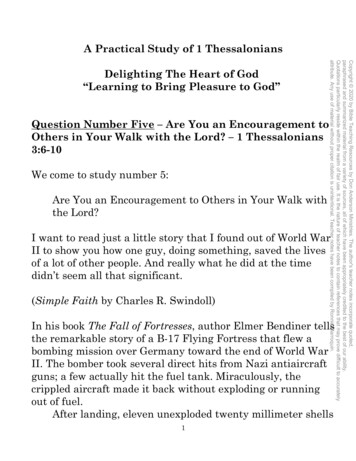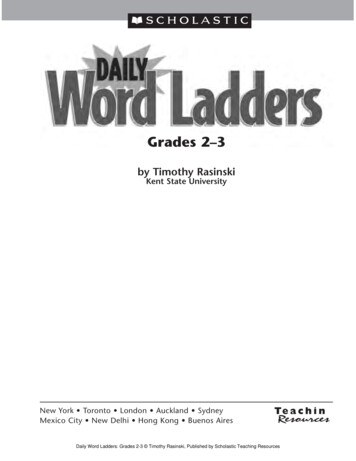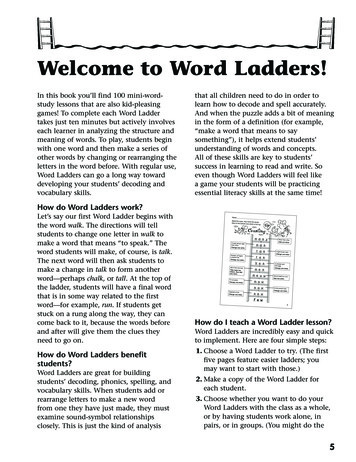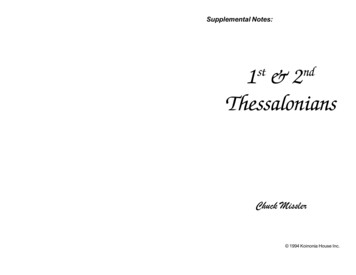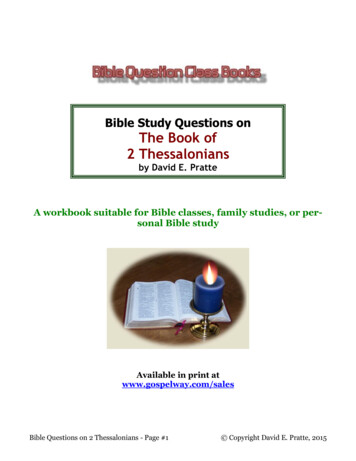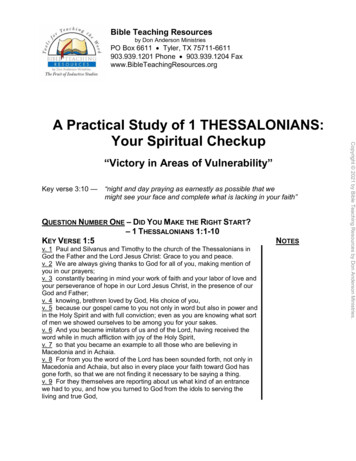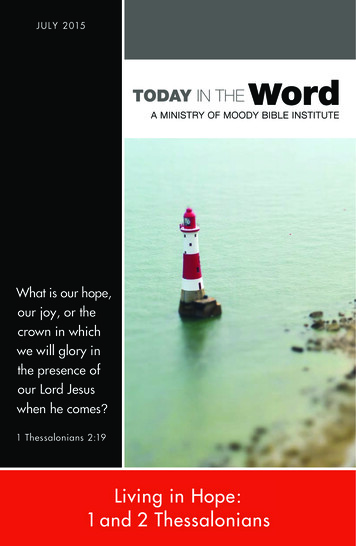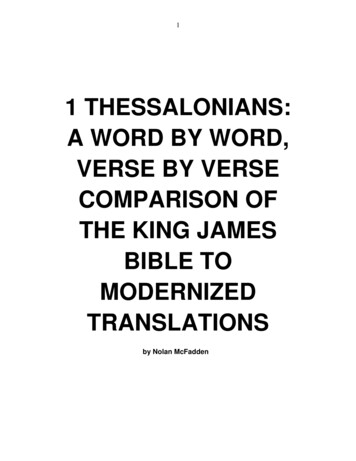
Transcription
11 THESSALONIANS:A WORD BY WORD,VERSE BY VERSECOMPARISON OFTHE KING JAMESBIBLE TOMODERNIZEDTRANSLATIONSby Nolan McFadden
2Table of ContentsINTRODUCTION .3PURPOSE OF THIS STUDY .6CHAPTER ONE: COMPARING THE DIFFERENCES .7CHAPTER TWO: HISTORICAL FACTORS THAT IMPACTED THE DEVELOPMENTOF THE TRADITIONAL GREEK TEXT AND THE CRITICAL GREEK TEXT 22CHAPTER THREE: MORE NIV, TNIV, NRSV, CEV, CEB, REB and GNT/TEVMISTRANSLATIONS .31CHAPTER FOUR: HISTORICAL EVIDENCES FOR A BYZANTINE PRIORITY .37CHAPTER FIVE: IMPACT OF ECUMENICAL TRANSLATION COMMITTEES .49CHAPTER SIX: HISTORICAL BACKGROUND OF 1 THESSALONIANS .54CHAPTER SEVEN: A COMPARISON OF THE BIBLE TRANSLATIONS IN1 THESSALONIANS .58IN CONCLUSION 140END NOTES .141This book is dedicated to Jim and Edna Taylor who taught us the importance ofdiligent work and loving “all” the saints (John 13:35, 1 Corinthians 16:14,Ephesians 1:15-16, Colossians 1:4; 3:23-24) 2013, revised 2021 Nolan McFadden
31 THESSALONIANS: A WORD BY WORD,VERSE BY VERSE COMPARISON OFTHE KING JAMES BIBLE TOMODERNIZED TRANSLATIONSby Nolan McFadden INTRODUCTION“But he answered and said, It is written, Man shall not live by bread alone, but byevery word that proceedeth out of the mouth of God.” – Christ Jesus (Mt. 4:4)During a past ministry trip, I had the opportunity of visiting and preaching insome villages in Mexico. A church group in the United States had generouslydonated some boxes of Bibles to distribute to believers during the trip. After aservice in one of these churches, we had the privilege of sharing Spanish Bibles.In this assembly was an older lady who quietly requested a Bible. As soon as Ihanded her the Bible, she immediately embraced her Bible and began weepingover it. Her love for our Lord Jesus and His precious Word was so obvious astears of joy ran down her cheeks. She had converted to Jesus Christ and biblicalChristianity years before. Yet, this was her first Spanish Bible. This was a copy ofGod’s Word in her native language. There was no doubt in our minds howprecious that Bible was to our sister in Christ. It was a cherished treasure. Thiswas a moment in time that I have never forgotten.As Christians, do we fully appreciate the great blessing of having God’s Wordin our own language? When you hold your Holy Bible, is it a cherished treasure toyou? Are you aware of the incredible suffering and personal sacrifices otherChristians endured in order that we might have the privilege of having our ownBibles to read and study?Known as the “Father of the English Bible,” William Tyndale was a gifted anddistinguished scholar skilled in the languages of Greek, Hebrew, Latin, English,Spanish, French and Italian. Tyndale wrote of an encounter that he had one daywith a Roman Catholic priest. Concerning this experience William Grady wrote,“Antagonized by his inability to refute Tyndale’s Biblical reasoning, theexasperated priest shouted, “It were better for us to be without God’s laws thanthe Pope’s,” whereupon an indignant Tyndale rejoined: I defy the Pope, and allhis laws; and if God spare my life, ere many years, I will cause a boy that driveththe plough to know more of the Scripture than you do!61
4With these daring words representing his lifelong motivation, Tyndale set out todeliver his benighted countrymen from the hopelessness of Romanism,declaring: Which thing only moved me to translate the New Testament. Because Ihad perceived by experience, how that it was impossible to establish the laypeople in any truth, except the Scriptures were plainly laid before their eyes in themother tongue.62” (1)John Foxe noted, “Before Tyndale’s day the English versions of the Bible hadbeen but translations of a translation, being derived from the Vulgate or olderLatin versions. Tyndale, for the first time, went back to the original Hebrew andGreek. And not only did he go back to the original languages seeking for thetruth, but he embodied that truth when found in so noble a translation that it hasever since been deemed wise by scholars and revisers to make but few changesin it; consequently every succeeding version [English versions which are basedon the TR] is in reality little more than a revision of Tyndale’s. It has been trulysaid that “the peculiar genius which breathes through the English Bible, themingled tenderness and majesty, the Saxon simplicity, the grandeur—unequalled,unapproached in the attempted improvements of modern scholars—all are here,and bear the impress of the mind of one man, and that man William Tyndale.”37 (2)Tyndale’s New Testament was completed in 1525. “By April 1526, Tyndale’sNew Testament was being read behind closed doors in England.” (3) But in 1534Tyndale was betrayed by a spy, arrested and imprisoned in Vilvoorde Castle. Hewas accused by Henry VIII of spreading sedition in England. William Tyndale, theservant of our Lord Jesus Christ, became a Christian martyr in 1536. He wasexecuted for the capital crime of “heresy.” Tyndale was strangled and thenburned at the stake. But before he died, it was reported that Tyndale prayed,“Lord! Open the King of England’s eyes.” (4) Not many years later, his prayer wasanswered when the king of England himself ordered the creation of an EnglishBible. Praise our LORD for answered prayers! Great are His works!William Tyndale was fully committed to our resurrected Savior, and to the taskof translating and distributing God’s Word – the Holy Bible (Romans 10:14-17).His testimony inspired thousands to carry on his work after his death.It is notable that Tyndale chose not to base his English translation of the NewTestament on the text of the Latin Vulgate (a true copy of the Alexandrian text)which was the Bible of the Roman Catholic church. Rather, William Tyndalechose to base his text primarily on the Greek New Testament of Erasmus (1516) –known as the Textus Receptus (Received Text based on the Byzantine/Majoritytext-base) in his translation work. Why? Professor Jakob van Bruggen explained,“The significance to Bible translation of one’s view of the reformation of thechurch and the authority of divine revelation was demonstrated in the contrastingattitudes of William Tyndale [Protestant] and Thomas More [Catholic]. Both wereinterested in the translation of the Bible into English. Tyndale from the standpointof a Reformer, More from that of an Erasmian humanist The Reformers had an
5entirely different attitude. To them, every science was bound to the Word of God.The church itself was subject to the authority of the Bible. The last word was notthe all-embracing unity of the church, but the all-commanding truth of the Word ofGod. Siding with the Reformers, Tyndale wished as a translator to serve thereformation of the church Tyndale was a Reformer and theologian and he evaluated the English usage bythe Scripture rather than accommodating Scripture to English usage. He did thechurch a favor by no longer translating the word presbuteros (elder) with theloaded and misleading term priest. The important point here is that althoughTyndale did not want to make revolutionary changes, he did not maintain existingwords [from the Catholic translation] for the sake of unity when the truth of theScripture demanded other words. More was rightly concerned about the unity ofthe church, but he did not see that this unity [true, biblical unity] could only bepreserved by subjection of the church and its Bible translation to the complete,revealed truth of God.” (5) In addition, we discover in HISTORY OF THECHRISTIAN CHURCH historian Philip Schaff noted that in John Calvin’s writtenresponse to the canons and decrees of the Roman Catholic Council of Trent(1545-1563) the Reformer exposed “the errors of the Vulgate, which the [RomanCatholic] Council put on a par with the original Hebrew and Greek originals, (6)In Tyndale’s New Testament of 1525 he translated the word “repentance” inplace of the term “penance” as translated in the Roman Catholic Bible. In likemanner, Tyndale translated “overseer” instead of “bishop.” “Elder” replaced theword “priest.” He used the word “congregation” in place of “church.” It isapparent in his New Testament that William Tyndale was seeking to restore thelost meanings of biblical words and the practices of the early church.Yet, centuries later, twenty-first century Christians are confronted with thesame important decision of which Bible to use. Many believers have validquestions and concerns about Bible translations. These are some goodquestions to ask when selecting a Bible: 1) Is the Bible that I’m consideringbuying a true, literal and faithful translation of the underlying Hebrew and Greektexts? 2) Was lexical and structural accuracy a priority of those who translatedthis Bible? 3) Can I trust this Bible? 4) Does it matter which Bible I use? 5) Whichstudy Bible is recommend by pastors who affirm sound doctrine? Why? 6) Is theBible I am using the faithfully preserved Word of God? 7) Are all Bibles preservedequally? 8) Are some Bibles more accurately translated from the Hebrew andGreek Scriptures than others? 9) On which of the two primary Greek texts(Traditional Text or Critical Text) is my Bible based? 10) Which method oftranslation was used by the translators who prepared my Bible? In this study wewill address these questions and more.
6PURPOSE OF THIS STUDY“Then said Jesus to those Jews which believed on him, If ye continue in my word,then are ye my disciples indeed; And ye shall know the truth,and the truth shall make you free.” – Jesus (John 8:31-32)The primary purpose of this study is, with our LORD’s help, to compare theKing James Bible to modernized translations of the Bible. Included in ourcomparison are the following translations of the Bible: the King James Bible(KJV) (7); the Literal Translation of the Bible (LTB) (8); the Revised StandardVersion (RSV) (9); the New Revised Standard Version (NRSV) (10); the NewInternational Version (NIV) (11); Today’s New International Version (TNIV) (12); theContemporary English Version (CEV) (13); the Revised English Bible (REB) (14);the Common English Bible (CEB) (15) and the Good News Translation (GNT) alsocalled Today’s English Version (TEV) (16). In our endeavor we will:1) Compare the primary differences between these English Bible versions.2) Consider historical factors that impacted the development of the TraditionalGreek Text and the Critical Greek Text.3) Observe mistranslations found in the modernized translations.4) Explore the historical evidences and reasons for a Byzantine Priority.5) Evaluate the historical impact of ecumenical translation committees.6) Provide a historical background of 1 Thessalonians7) We will conclude with a word by word and verse by verse comparison of fifteentranslations of 1 Thessalonians. To enhance our comparison, two interlineartranslations and three Greek translations of 1 Thessalonians are included.
7CHAPTER ONECOMPARING THE DIFFERENCES“Heaven and earth shall pass away, but my words shall not pass away.” – Jesus(Matthew 24:35)In what ways are the King James Bible and the modernized translations of theBible different? Most of the differences can be summarized in two categories:1) Method of translation2) The source of textual contentIn this chapter we will address both the differences in methods of Bibletranslation, and consider the importance of having a correct source for textualcontent.One of the primary reasons for the differences in translations is identified in thebook entitled The Identity of the New Testament Text II by Wilbur Pickering. It isknown as “the textual problem.” (17) Mr. Pickering explained, “That there is aproblem concerning the identity of the Greek text of the New Testament is madeclear by the existence of a number of competing editions in print. By competing Imean that they do not agree with one another as to the precise wording of thetext. Such disagreement is possible because no two of the ancient Greekmanuscripts (handwritten copies) known to us are identical in wording, and weare dependent on those copies because the Apostle’s Autographs, or originaldocuments, are no longer in existence. (They were probably worn out well beforeA.D. 200) In short, we are faced with the challenge of recovering the original wording ofthe text from the surviving manuscripts, no two of which entirely agree. In thistask we may also appeal to copies of the ancient Versions (translations intoSyriac, Latin, Coptic, etc.) and to the surviving writings of the early churchFathers where they quote or refer to New Testament passages. There are over5,000 extant (known) Greek manuscripts (hereafter MSS, or MS when singular) ofthe New Testament. They range in size from a scrap with parts of two verses tocomplete New Testaments. They range in date from the second century to thesixteenth.2 They come from all over the Mediterranean world. They containseveral hundred thousand variant readings (differences in the text). The vastmajority of these are misspellings or other obvious errors due to carelessness orignorance on the part of the copyists. However, many thousands of variantsremain which need to be evaluated as we seek to identify the precise originalwording of the text To the extent that you may be aware of these matters you may well haveaccepted as reasonable the statements usually made to the effect that the very
8considerable improvement in our lack of available materials (Greek manuscriptsand other witnesses) and in our understanding of what to do with them(principles of textual criticism) has made possible a closer approximation to theoriginal text in our day than was achieved several hundred years ago. Thestatements to be found in the prefaces of some versions give the reader theimpression that this improvement is reflected in their translations. For example,the preface to the Revised Standard Version, p. ix, says: The King James Versionof the New Testament was based upon a Greek text that was marred by mistakes,containing the accumulated errors of fourteen centuries of manuscript copying[not true; almost all TR readings are ancient] .We now possess many moreancient manuscripts of the New Testament, and are far better equipped to seek torecover the original wording of the Greek text And the preface to the New International Version, p. viii, says: The Greek textused in the work of translation was an eclectic one. No other piece of ancientliterature has so much manuscript support as does the New Testament. Whereexisting texts differ, the translators made their choice of readings in accord withsound principles of textual criticism. Footnotes call attention to places wherethere is uncertainty about what constitutes the original text But if you have used a number of the modern versions you may have noticedsome things that perhaps intrigued, bewildered, or even distressed you. I amthinking of the degree to which they differ among themselves, the uncertainty asto the identity of the text reflected in the many footnotes regarding textualvariants, and the nature and extent of their common divergence from the KingJames Version. The bulk of the differences between the modern versions ispresumably due to the differences in style and translation technique. However,although they are in essential agreement as to the Greek text used, as opposed tothat underlying the AV, no two of them are based on an identical Greek text. Norhave the translators been entirely sure as to the precise wording of the text –while some versions have few notes about textual variation, others have many,and even in these cases by no means all the doubts have been recorded.1 ” (18)Whereas, the translation work displayed in the King James Bible (KJV), alsoknown as the Authorized Version (AV), is very different. Translators of the KingJames Bible used the “formal equivalency” (or “verbal equivalency”) approach toBible translation. They diligently labored in a “word by word” and a grammatical“structure by structure” approach of translation from the Hebrew and GreekScriptures. Thus, the KJV can be further regarded as a “total linguistic”translation.In addition, the King James Bible is, primarily, based on the Greek NewTestament known as the Textus Receptus (Received Text) 1598 of TheodoreBeza. This text is also referred to as the Traditional Text. The translators of thetranslations of the Textus Receptus (Received Text) Greek New Testament andthe King James Bible relied heavily on the Byzantine/Majority text-base in their
9translation work. This becomes very important when we consider all factorsimpacting the historical development of the primary families of manuscripts. Themanuscript evidence for the Greek New Testament include: papyri, uncials,numbered uncials, minuscules and lectionaries.Regarding the predominant Byzantine text basis of the Textus Receptus andthe King James Bible, Maurice Robinson and William Pierpont explained, “ Earlyprinted editions of the Greek New Testament reflect a general agreement with theByzantine-era manuscripts upon which they were based. Such manuscripts andearly printed editions are commonly termed “Textus Receptus” or “ReceivedText” documents, based upon the term applied to the Elzevir 1624 printed Greekedition. Other editions commonly termed “Textus Receptus” include the editionsof Erasmus 1516, Stephens 1550, and Beza 1598. George Ricker Berry hascorrectly noted that “in the main they are one and the same; and [any] of themmay be referred to as the Textus Receptus. 7 All these early printed Greek New Testaments closely paralleled (but were notidentical with) the text which underlies the English-language King James orAuthorized Version of 1611. That version was based closely upon the Greek textof Theodore Beza 1598, which differed but little from its Textus Receptuspredecessors or from the derived text of the few Byzantine manuscripts uponwhich those editions were based. Nevertheless, neither the early Englishtranslations nor the early printed Greek New Testaments reflected a perfectagreement with the predominant Byzantine/Majority Textform, since no singlemanuscript or small group of manuscripts is 100% identical with the aggregateform of that text.” (19)Commenting on the method of translation used by translators of the KingJames Bible R.B. Ouellette observed, “Methodology is based on principle.Principles are based on one’s paradigm of truth. The methodology employed bythe translators of the Authorized Version are radically different from themethodology used by the translators of the modern versions.The Authorized Version committee was made up of fifty-seven men and dividedinto six companies. Each of these companies worked in different geographicalareas. Each company was divided and assigned its own sections of Scripture.Each individual translator was responsible to translate a portion of Scriptureassigned to him. Once these individual translations were completed, thecompany assembled together in order to compare, discuss, and defend theirwork.When a passage seemed obscure or difficult, additional “learned men” wereconsulted. Each book was reviewed and examined at least fourteen differenttimes during the lengthy process. Contrast this with the New InternationalVersion Committee which boasted of going over each passage of Scripture threetimes during their translation process. The technique employed by the AuthorizedVersion committee is known as “formal equivalency” or “verbal equivalency.”
10This meant that both the words and the forms of the words were rendered asclosely as possible from the Hebrew or Greek into English.1 This is in distinctionto “dynamic equivalency” used for the NIV – a belief that it is the message andthoughts, not the words, which are important. It is readily apparent that the KingJames translators had a high view of God’s Word. The manuscripts, previousEnglish versions (such as the Geneva Bible, the Bishops Bible, and others), andsources in other languages were handled with care, and the new translation wasmeticulously reviewed multiple times in order to ensure fidelity to the underlyingtext ” (20)Whereas, the New International Version (NIV); Today’s New InternationalVersion (TNIV); the Contemporary English Version (CEV); the Common EnglishBible (CEB); the Revised English Bible (REB) and the Good News Translation/Today’s English Version (GNT/TEV) are products of the “dynamic equivalency”model of translation introduced and popularized by Eugene A. Nida and others inthe twentieth century. This method of translation generally follows a “thought bythought” approach of translation from the Greek text. What makes these textsappealing to many is that the texts have been “modernized” for the English Biblereader. There is familiar language which is usually easy to understand. Yet, forthose concerned about translation accuracy of these modern translations twoessential questions must be addressed. 1) Are these English versions translatedaccurately from the underlying Hebrew and Greek Scriptures? 2) Is the CriticalText (or Eclectic Text) on which these modern translations are based faithful tothe Received Text of Scriptures used by early Christians? Unfortunately, there aresome inherent problems in the “dynamic equivalency” translation approachobserved in the NIV, TNIV, CEV, CEB, REB and GNT/TEV.First, since a careful “word by word” translation approach was not used by itstranslators, LEXICAL INACCURACY is frequently found within these translations.English words which do not accurately match the meanings of words from theGreek text are often used in the translations. For example, in the verse by versecomparison of I Thessalonians in chapter seven of this book notice that “andsisters” was added fourteen times in the TNIV and CEB after the word “brothers”in this epistle. In like manner, these extra words were added twelve times in theNRSV which is supposedly a modern, formal equivalence translation. Why wasthis change made? There was certainly no valid basis for the change found in theunderlying Greek text. The word found in the Greek text is the masculine, pluralGreek word . One cannot help but speculate regarding the motives of the translators. Werethese words added in order to modernize the text and appeal to female readers?Was this a change designed to help broaden the market of the TNIV, NRSV andCEB in order to increase sales by making it more female-friendly or was theresomething more involved? Would not similar changes in the New Testamentserve ideologically motivated feminism (i.e. journey to a gender neutral Bible)?
11In the preface of the New Revised Standard Version we obtain the facts.Writing for the committee, Bruce Metzger explained, “ many in the churcheshave become sensitive to the danger of linguistic sexism arising from theinherent bias of the English language towards the masculine gender, a bias thatin the case of the Bible has often restricted or obscured the meaning of theoriginal text The mandates from the Division specified that, in references to menand women, masculine-oriented language should be eliminated as far as this canbe done without altering passages that reflect the historical situation of ancientpatriarchal culture.” (21) Thus, submitting to the pressures of those embracingideologically motivated feminism, the NRSV committee pursued the creation of anew “gender language inclusive” version.Notice that Mr. Metzger blamed the alleged “linguistic sexism” found in theEnglish Bible as “arising from the inherent bias of the English language towardsthe masculine gender.” But our fearless translator failed to mention that it wasthe authors themselves of the Hebrew and Greek Scriptures who chose tofrequently use “masculine-oriented language” in their writings. Therefore, anaccurate translation of those Scriptures would reflect the same. And that,desiring to be true to the Scriptures of the faith once delivered to the saints, weshould also translate those Scriptures exactly as they were written.In like manner, the word is mistranslated in the REB. In place of“brothers” or “brethren,” we find the words “my friends” used six times in 1Thessalonians 2:1; 2:9; 2:14; 2:17; 3:7 and 5:1. The word is likewise changed to“My dear friends” in 1:4; “friends” in 1 Thes. 4:1; 4:13; 5:4; 5:12 and 5:14. Thechange is to “fellow-Christians” in 1 Thes. 4:10; 5:26. Regardless of the motiveand/or motives of the translators of the TNIV, NRSV, CEB and REB, these wordswere erroneously translated from the masculine, plural Greek word in 1:4;2:1; 2:9; 2:14; 2:17; 3:7; 4:1; 4:10; 4:13; 5:1; 5:4 (“beloved” in the NRSV); 5:12;5:14 (“beloved” in the NRSV) and 5:26. The correct translation of this Greek wordis “brethren” or “brothers” as translated in the KJV and LTB. To their credit,even the RSV and NIV translators translated this word correctly.Nevertheless, there have been a number of other changes in the text of 1Thessalonians in the NIV, TNIV, NRSV, CEV, CEB, REB and GNT/TEV which resultin our understanding of the words of the text being changed and/or diminished.For example, in the TNIV we observe the following changes from the Greek text:“like young children” (2:7); “daily life” and “win the respect” (4:12); “not bedependent on anybody” (4:12); “strive” (5:15); “harmful” (5:22) and “God’speople” (5:26). Some similar modifications to the text are found in the NRSVincluding: “inspired” (1:6); ‘we were made orphans” (2:17); “be dependent on noone” (4:12).Some of the most obvious mistranslations in the modern versions occurring in1 Thessalonians include:
121) Changing the words, “ ” (TR, BT, and UBS) correctlytranslated “Quench not the Spirit” (KJV) and “The Spirit do not quench,” (AlfredMarshall’s rough reading) to “Do not put out the Spirit’s fire” (NIV) and to “Do notstifle inspiration” (REB) in 1 Thessalonians 5:19. Thus, “the Spirit,” referring tothe Holy Spirit, is thereby changed to mere “inspiration” in the REB and a new“fire” in the NIV.2) Changing the Lord’s “ ” (TR, BT, UBS) of 1 Thessalonians 4:2,which is correctly translated “commandments” (KJV) or “injunctions” (AM, LTB),to “instructions” in the NIV, TNIV, GNT/TEV, NRSV, CEB, CEV and to “rules” inthe REB. The word “instructions” does not carry the same meaning as“commandments” in the mind of the reader. A “command” implies that it isimperative to obey the teaching. Whereas, an “instruction” is not necessarily animperative. It does not carry the same strength or force of meaning. The meaningis diminished. As W. E. Vine pointed out concerning , “a proclamation,a command or commandment, is strictly used of commands received from asuperior and transmitted to others. It is rendered “charge” in Acts 16:24; ” (22)Thus, “instructions” in the modern versions is not an adequate translation of“ .” It should be noted that one of these important “commandments” isthe command from our Lord Jesus for Christians to “abstain from fornication,”(4:3).3) Changing the word “ ” (TR, BT, UBS) in 1 Thessalonians 1:10; 5:9 from thecorrect translation of “wrath” or “wrath(s)” (KJV, AM, LTB) to “retribution” in theREB. There is a difference between the words “wrath” and “retribution.” The wordretribution may refer to either reward or punishment. (23) The word retributiondoes not sufficiently convey the correct meaning from the Greek text. Whereas,“ ” in the contexts of 1 Thessalonians 1:10 and 5:9 specifically refers to theLORD’s fierce, eternal wrath against those that, “know not God, and that obey notthe gospel of our Lord Jesus Christ.” (2 Thessalonians 1:8-9) (24) Also, ourLORD’s wrath will be expressed by his judgments on the world during the futuretime of great tribulation to avenge the shed blood of his martyrs (Rev. 14-19). Thiswill occur before and at His return to earth from Heaven. In English the word“wrath” means more than anger. It carries the meaning of an intense, great angerwhich results in action for punishment or vengeance. (25) Therefore, in thecontexts of our texts, “wrath” is the correct word choice in English to match“ ” from Greek.Second, extra words which are not found in the Greek text were added to theNIV, TNIV, NRSV and GNT/TEV texts in order to amplify the concepts. Examplesare numerous including: “given” (1:6 in the TNIV); “inspired” (1:6 in the NRSV);“about it” (1:8 in the TNIV and NRSV); “They tell” (1:9 in the TNIV); “of thoseregions” (1:9 in the NRSV); “All” (1:9 in the GNT/TEV); “spring” (2:3 in the NIV,TNIV and NRSV); “while” (2:9 in the TNIV and NRSV); “as” (2:9 in the GNT/TEV);“indeed” (2:13 in the TNIV); “in their effort” (2:16 in the TNIV); “we were
13orphaned” (2:17 in the TNIV); “we were made orphans” (2:17 in the NRSV); “madeevery effort” (2:17 in the NIV and TNIV); “spreading” (3:2 in the NIV and TNIV);“proclaiming” (3:2 in the NRSV); “quite well” (3:3 in the NIV and TNIV); “Indeed”(3:3 in the NRSV); “really” (3:8 in the NIV and TNIV); “this instruction” (4:8 in theNIV and TNIV); “suffer” (5:9 in the NIV and TNIV); “hard” (5:12 in the NIV andTNIV) and “fire” (5:19 in the NIV).Third, we observe words and structures changed from those found in the Greektext in order to communicate the “ideas” of the authors as interpreted by thetranslators. For instance, in 1 Thes. 1:3 the words “produced,” “prompted” and“inspired” are added in the NIV and TNIV. In 1 Thes. 1:5 – “simply” and “lived” areadded in the NIV and TNIV. 1 Thes. 2:2 is changed with the addition of “but withthe help” in the NIV and TNIV. In 1 Thes. 2:2 the text is altered with the addition ofthe words “spite of” in the NIV and “the face of” in the TNIV. In 1 Thes. 2:3 “arewe trying” is added to the text in the NIV and TNIV. A similar modification of thetext is seen in the GNT/TEV (1992) with the additi
6) Provide a historical background of 1 Thessalonians 7) We will conclude with a word by word and verse by verse comparison of fifteen translations of 1 Thessalonians. To enhance our comparison, two interlinear translat

